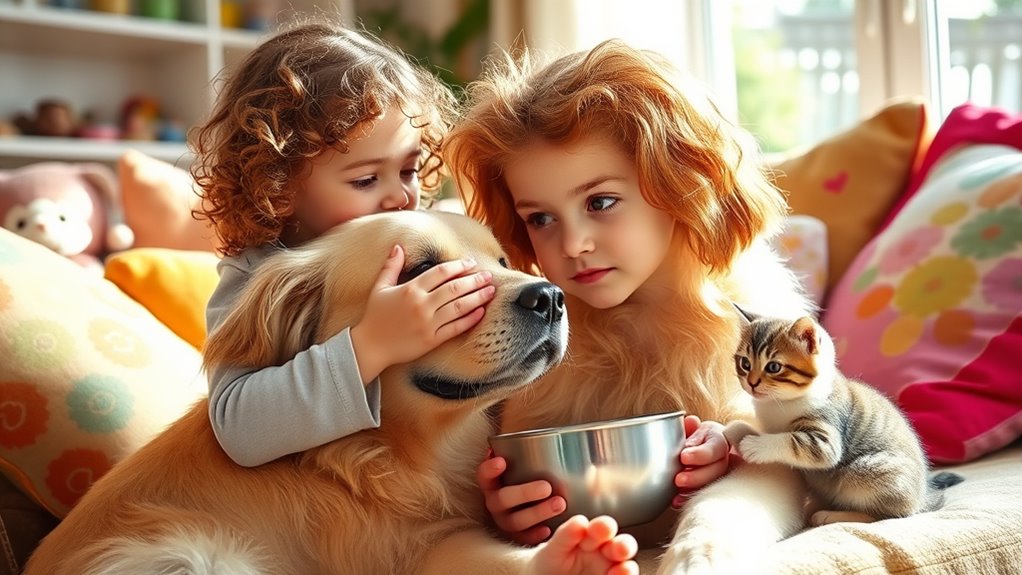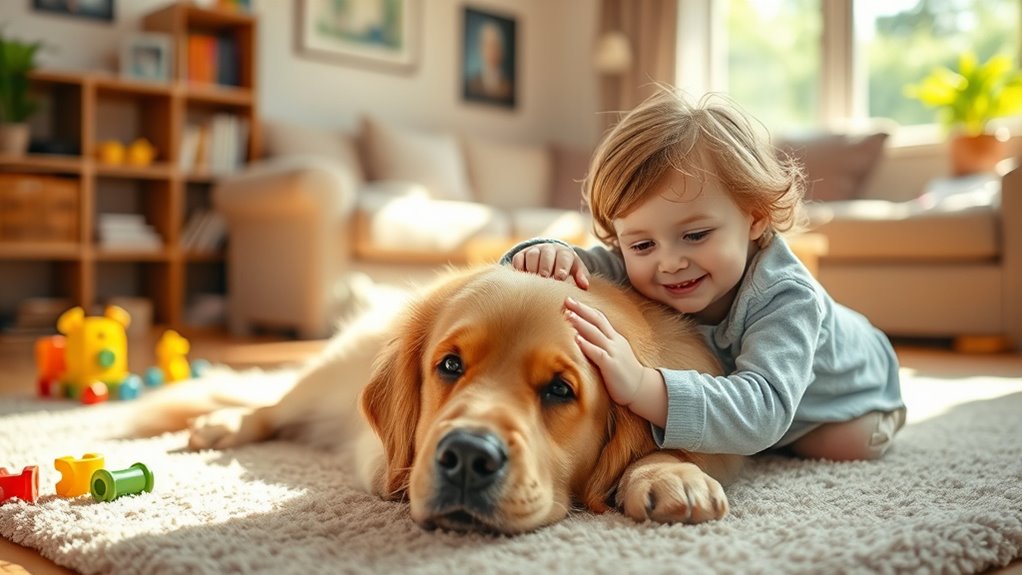When teaching kids about pets, emphasize respect and gentle handling. Show them how to support animals properly and recognize signals of stress or discomfort. Set clear rules, like not disturbing pets during rest or feeding, and supervise all interactions. Reinforce kindness with praise and rewards. By modeling calm, respectful behavior yourself, you help your child build trust and care for animals. Keep exploring for more tips on creating safe, loving bonds between your child and pets.
Key Takeaways
- Teach children to handle pets gently, supporting their bodies and avoiding sudden movements or rough play.
- Model calm, respectful interactions to foster trust and proper behavior around animals.
- Establish clear boundaries, like avoiding disturbing pets during rest or feeding times.
- Supervise all interactions to ensure safe handling and reinforce correct techniques consistently.
- Use positive reinforcement, praise, and routines to encourage gentle, caring behavior toward pets.

Bringing a pet into your home can be a wonderful way to teach kids responsibility, empathy, and companionship. As you introduce your child to caring for a pet, it’s essential to focus on pet safety and handling techniques. When guiding your child, emphasize that pets are living beings with feelings, and they require gentle, respectful treatment. Start by teaching your child how to approach a pet calmly and confidently, avoiding sudden movements or loud noises that can startle or scare the animal. Explain that handling techniques matter—a pet should be held securely but gently, supporting their body to prevent discomfort or injury. For example, when picking up a small animal, show your child how to cradle it with both hands, ensuring it feels safe and supported. Reinforce that rough handling or pulling on ears, tails, or fur can hurt the pet and damage trust, so patience and kindness are key.
It’s essential to establish rules around pet safety from the outset. Teach your child to recognize signs that a pet might be stressed or uncomfortable, such as growling, hissing, or trying to escape. Encourage them to respect these signals and give the animal space when needed. By modeling calm, respectful interactions, you help your child understand that animals deserve the same care and consideration as people. You should also demonstrate proper handling techniques yourself, so your child can see how to interact gently during play or grooming. This might include showing them how to hold a dog with a loose grip or how to pet a cat softly along the back. Consistent supervision is important to ensure that your child practices safe handling techniques and that the pet remains comfortable and secure.
Teaching pet safety also involves setting boundaries about where and when pets can be touched or played with. For example, remind your child not to disturb a pet when it’s eating, sleeping, or in a resting spot. This teaches respect and prevents accidental bites or scratches. Incorporate routines where your child helps with feeding, grooming, or cleaning up, reinforcing responsibility while practicing handling techniques in a safe environment. As your child learns these skills, praise their gentle behavior and patience, fostering a positive bond built on trust and respect. Additionally, explaining the importance of positive reinforcement can help your child understand how rewards encourage good behavior and gentle interactions with pets.
Frequently Asked Questions
How Can Pets Help Teach Kids Empathy?
You can see how pets help teach kids empathy by fostering emotional bonding and nurturing responsibility. When kids care for a pet, they learn to recognize and respond to its feelings, building empathy. Taking on responsibilities like feeding and grooming encourages compassion and patience. Through these interactions, kids develop a deeper understanding of others’ emotions, which strengthens their ability to connect and empathize in all areas of life.
What Are Common Signs of Allergies in Children?
Think of allergy symptoms like a warning light in your car—if you notice sneezing, itchy eyes, or skin rashes, your child might have pet allergy symptoms. These signs often appear after exposure to pets. To prevent allergies, follow allergy prevention tips like regular cleaning and keeping pets out of bedrooms. If symptoms persist, consult a doctor to get proper testing and management, ensuring your child stays comfortable and healthy.
How Do I Introduce a New Pet to My Child?
When introducing a new pet to your child, start with gentle pet training to help the animal feel comfortable. Keep your child supervised at all times, especially during initial interactions. Explain the importance of respecting the pet’s boundaries and encourage calm, gentle behavior. Gradually increase their time together, observing how your child responds. This approach fosters a positive bond while ensuring safety and teaching your child responsibility and care for the pet.
What Safety Precautions Should Kids Follow Around Pets?
Oh, the irony of teaching kids pet safety—like trusting a child to read a dog’s mind! You should supervise all child pet interactions, teach your kids gentle handling, and avoid rough play. Keep an eye out for signs of discomfort in pets, and never leave young children alone with animals. These safety precautions ensure positive pet safety experiences and help your child develop respect and caring habits around animals.
How Can Pets Assist Children With Special Needs?
You can help children with special needs by introducing them to animal-assisted therapy and emotional support pets. These animals provide comfort, reduce anxiety, and encourage social interaction. As a caregiver, you facilitate bonding with the pet, which can boost confidence and emotional well-being. Regular interaction with these animals helps children develop empathy and trust, making daily challenges easier to manage and improving their overall quality of life.
Conclusion
By teaching kids to respect and care for pets, you’re fostering empathy and responsibility that last a lifetime. Studies show that children who grow up with pets tend to develop better social skills and emotional intelligence. Remember, guiding your kids in proper pet interaction not only keeps everyone safe but also strengthens your bond. So, embrace these lessons today—your efforts today shape compassionate, caring individuals tomorrow.









